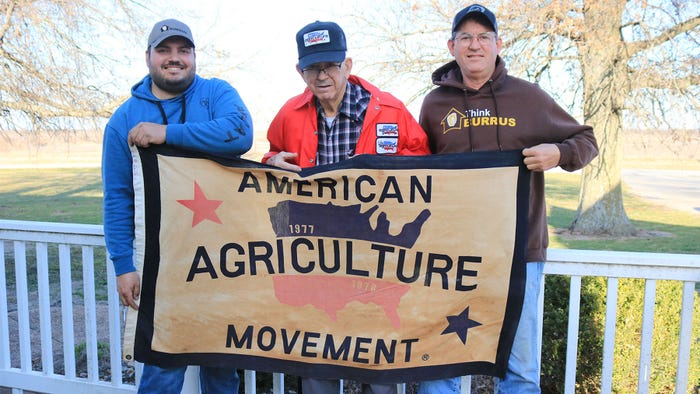March 19, 2024

by Laura Handke
Sitting on the sofa in his grandpa’s living room, Justin Grimes, the third generation at Grimes Farms Inc., sifts through a tattered Country Mart paper grocery sack of newspaper clippings, pamphlets, directories and maps.
“Crime Doesn’t Pay … Neither Does Farming.” A “Deere John” slogan that served as one of many puns for the 1977 farm strike alludes to just how dire the farm economy was in the late ’70s, and how those years helped to springboard what would become known as the 1980s farm crisis.
At the time, Earl Grimes, founder and patriarch of Grimes Farms Inc. in Osborn, Mo., was one of millions of farmers trying to make ends meet.
“The price of equipment had skyrocketed from the early ’70s, and the prices that we were getting for grain were going nowhere,” he says. “It was hard to survive when things cost three times as much as they had a few years prior, and we were getting paid the same.”
So, Earl and his late wife, Thelma, joined the American Agricultural Movement that culminated in the 1979 Tractorcade on the National Mall.
Driving change for farmers
The American Agricultural movement was started by five farmers in Colorado, which gained national attention when the first tractor left Bushland, Texas, on Jan. 15, 1979, on a national tractorcade.
“It snowballed from there,” Earl says. “As the tractors would come through towns, more would join in, gaining momentum all the way to Washington, D.C.”
In early February, Earl and Thelma joined. The couple set out in their 27-foot motorhome that housed a group of six local farmers throughout the demonstration. A neighbor drove Earl’s twin screw 10-wheeler that carried the farm’s John Deere 3020.
For two weeks, Earl was one of thousands of farmers who demonstrated on the National Mall to establish parity — a fair price, adjusted for farm expense inflation, that allowed farmers to maintain buying power.
“It was a very organized effort by the time we got to Washington, D.C.,” recalls Earl, as Justin holds up a yellowing memo of Capitol phone numbers and key congressmen and senators to visit with.
The memo offered farmers these words: “Ask your senator to put pressure on committee. Wear strike caps, be courteous and do not be discouraged. If someone says no, just go to work on someone else and send more people in to work on the negative people.”
“The biggest thing to come out of the American Ag Strike was the fuel alcohol industry,” says Earl’s son, Jerald, who serves on the board of the Craig, Mo., ethanol plant — a venture Earl was instrumental in. “But that’s its own story.”
In addition to the demonstration and lobbying efforts, farmers, as farmers do, became a helping hand to the city.
Showing a farmer’s heart
“As we came onto the National Mall, we were barricaded in,” Earl recounts. “Once you were in, you couldn’t get out.”
“Three or four days after we had been there, a big snowstorm came through, and the police let tractors with blades out of the tractorcade camp to help clean the streets of D.C. There are all kinds of these side stories,” Earl says with a smile as he remembers.
“There were also a lot of farmers who gave tractor rides to the kids in D.C. Most of them had never seen a tractor before. And when it was all over, farmers went back to reseed and fertilize — they restored any damage that had been done to the National Mall.”
As the historic protest concluded, government officials were left with a list of names, a sign-out of sorts, Earl remembers.
“When it was all over, they released every tractor one at a time, and we all had to sign a piece of paper that said we wouldn’t ever return,” he says.
Thelma not only lived the experience with her husband, but she also took care to preserve the stories for generations to come, like Jerald and Justin. The family’s collection is museum-worthy and tells the firsthand account of the entire movement, from both mainstream media and the American Agriculture movement’s internal communications.
Handke writes from Easton, Kan.
You May Also Like




